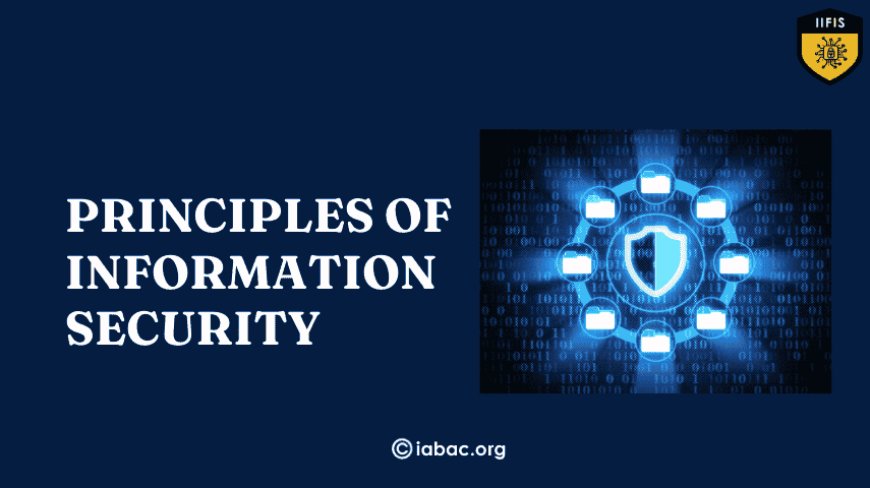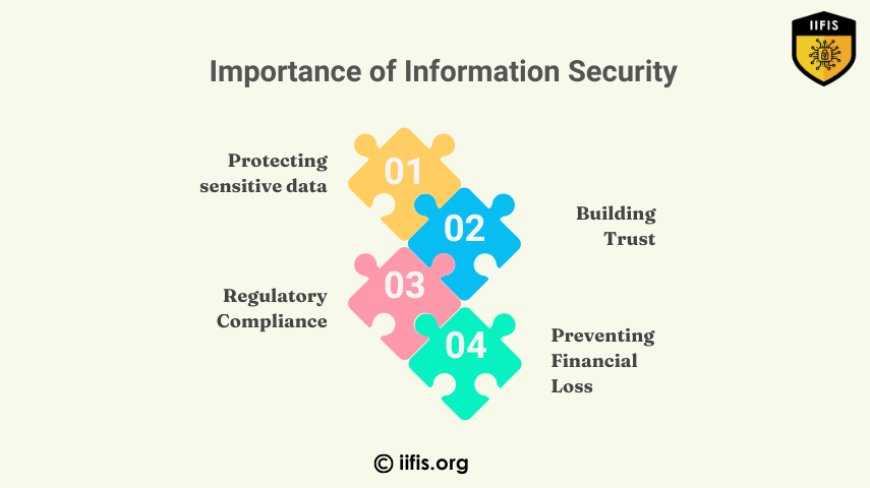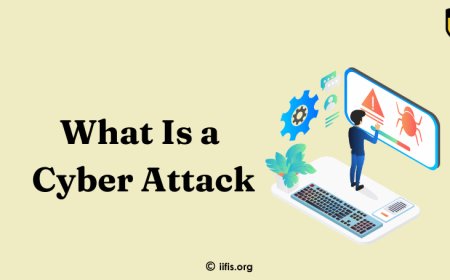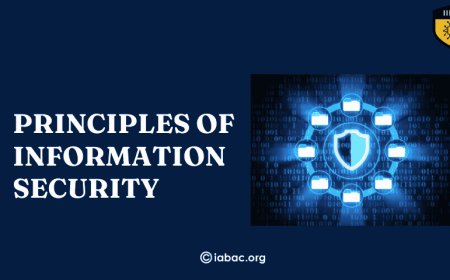Core Principles of Information Security for Data Protection
Understand the core principles of information security to protect your data, ensure privacy, and safeguard against potential cyber threats in the modern digital era.

Securing information is more important than ever. With so many things happening online, cyber threats are constantly evolving, putting our data at risk.!!! Whether it’s your details, banking info, or confidential work documents, keeping that data safe is essential.
From my own experience, I’ve realized that protecting information isn’t just for big businesses or organizations—it's something everyone should care about. Whether you’re handling personal data or managing sensitive work information, following key security principles can help prevent unauthorized access, protect against data breaches, and keep everything secure. The digital world can be risky, but by staying aware and proactive, we can protect what matters most.
1. Confidentiality
Confidentiality is about keeping information safe by ensuring that only the right people can access it. This helps prevent unauthorized individuals from seeing, changing, or sharing sensitive data. To protect confidentiality, companies use methods like access controls, encryption, and authentication.
For instance, businesses keep things like customer details—such as Social Security numbers, credit card info, and login credentials—secure by encrypting them. This means that even if someone tries to access the data; they won’t be able to read it without the correct key. Similarly, strong passwords and multi-factor authentication (MFA) help protect personal accounts from unauthorized access.
How to Keep Information Confidential:
-
Encryption: turning data into unreadable text that only authorized people can unlock with a special key.
-
Access Control: restricting who can view or edit data, ensuring only the right people have access.
-
Password Management: Using strong passwords and encouraging people to update them regularly to keep accounts safe.
2. Integrity
Integrity is another key principle of information security. It’s all about ensuring that data stays accurate and unchanged unless someone with the right permission makes an update. Without proper integrity controls, hackers could easily alter important information without being detected, which could lead to fraud or data loss.
For example, in online banking, integrity makes sure that account balances and transaction records stay correct and unmodified. When a customer deposits money or transfers funds, the information remains secure and untouched, preventing any tampering.
How to Maintain Integrity
-
Hashing: This involves turning data into a fixed-length code, making it easier to check if the data has been altered.
-
Checksums: These are used to verify data’s integrity, ensuring it hasn’t changed during transmission or storage.
-
Version Control: This helps track and manage changes made to important documents or data, making it easier to identify when changes were made.
3. Availability
Availability is all about making sure that data and services are accessible when needed. For businesses, this means ensuring that employees, customers, and authorized users can get the information they need without delays or interruptions. Keeping data and systems available is vital to maintaining business operations smoothly. For instance, a company’s website should be up and running around the clock, so customers can access products, services, or account information at any time.
Cyber threats, like denial-of-service (DoS) attacks, can threaten availability by flooding a system with too much traffic, making it crash or become inaccessible. To prevent this, businesses take steps to keep systems secure and available at all times.
How to Maintain Availability:
-
Redundancy: This involves creating backup systems and storage, so if something fails, there’s always a way to keep things running.
-
Disaster Recovery Plans: Have plans ready to quickly recover lost or inaccessible data after an attack or failure.
-
Load Balancing: This technique helps spread the traffic across several servers, preventing one server from getting overloaded.
4. Authentication
Authentication is the process of confirming the identity of users, devices, or systems before granting them access to sensitive data. This is crucial for ensuring that only authorized individuals are able to access confidential information. Effective authentication helps prevent unauthorized people from impersonating someone else and accessing protected data.
There are several types of authentication methods used to ensure security:
-
Passwords: The most commonly used form of authentication, but it’s not always the most secure. Passwords can be guessed, stolen, or cracked through various techniques.
-
Biometric Authentication: This method uses unique physical characteristics such as fingerprints, facial recognition, or iris scans to verify identity. Biometric authentication offers a higher level of security since it’s harder to replicate someone’s physical traits.
-
Multi-Factor Authentication (MFA): This method combines two or more authentication factors. For example, it might require a password plus a one-time code sent via text message. MFA provides an added layer of security, ensuring that even if one authentication method is compromised, access is still protected.
How to Implement Effective Authentication:
-
Use Strong Passwords: Ensure passwords are long, complex, and unique. Avoid using easily guessable information like birthdates or common words.
-
Enable Multi-Factor Authentication (MFA): Whenever possible, use MFA to add an extra layer of protection. Even if someone gets hold of your password, they won’t be able to log in without the second factor.
-
Consider biometric authentication: For higher levels of security, biometric authentication can be used to confirm identities, especially in high-stakes environments like banking or secure corporate systems.
5. Non-Repudiation
Non-repudiation is a crucial concept in information security that ensures individuals cannot deny their actions once they have been performed. It allows organizations to trace and attribute actions back to the person who executed them, preventing anyone from denying responsibility. This principle is particularly important in online transactions, contracts, and communications, where it’s essential to have clear proof of who did what and when.
For instance, in e-commerce, non-repudiation ensures that when a customer places an order, they cannot later deny making the purchase. This is vital for preventing disputes and fraudulent claims. Non-repudiation can be achieved through tools like digital signatures and audit trails, which record all activities and help verify the authenticity of actions.
How to Ensure Non-Repudiation:
-
Digital Signatures: These are cryptographic techniques that confirm a piece of data (like an email or document) was sent by a specific person and has not been altered. Digital signatures ensure that the sender cannot deny sending the message, providing proof of authenticity.
-
Audit Trails: Audit trails are records of every action or transaction involving sensitive data. They track who accessed or modified the information, providing a detailed log that can be used to verify actions and hold individuals accountable.
6. Accountability
Accountability is a fundamental principle in information security that ensures actions are traceable to the individuals responsible for them. This principle helps organizations monitor user behavior, detect unauthorized actions, and enforce security policies. By holding users, systems, and devices accountable for their actions, organizations can maintain a secure environment and ensure that all activities are properly tracked.
For example, logging systems are commonly used to track and monitor user activity. If an employee accesses sensitive data without authorization, their actions can be traced back to them through logs, allowing for appropriate corrective measures or consequences. Accountability also serves as a deterrent to malicious actions, as users know their actions are being monitored.
How to Implement Accountability:
-
Activity Logging: Keep detailed logs of all user actions, especially those involving sensitive data or systems. These logs can help identify suspicious behavior and detect potential security incidents.
-
Monitoring Systems: Use security software that continuously tracks system activity, identifying unauthorized actions in real-time. This enables quicker response times to any breaches or policy violations.
-
Access Reviews: Conduct regular reviews of user access rights to ensure compliance with security policies. This ensures that only authorized individuals have access to sensitive information and systems.
7. Security Training and Awareness
One of the most overlooked but critical aspects of information security is educating individuals about security practices. Human error is often a major cause of security breaches, so regular training and awareness programs can significantly reduce risks. Employees and users must understand the risks of phishing, social engineering attacks, and proper password management.
How to Foster Security Awareness:
-
Regular Training: Hold regular security awareness training sessions for employees.
-
Phishing Simulations: Test employees with mock phishing emails to help them identify threats.
-
Security Policies: Ensure all staff understand and follow company security policies.
Importance of Information Security
In today’s technology-driven world, information security is vital. The following are some key reasons why information security is important:
-
Protecting sensitive data: Information security helps prevent unauthorized access to personal, financial, and business data.
-
Regulatory Compliance: Many industries are subject to regulations (such as GDPR, HIPAA, etc.) that require organizations to secure data.
-
Building Trust: Strong information security practices build customer trust, as they are confident that their data is protected.
-
Preventing Financial Loss: A data breach can result in significant financial loss due to legal penalties, reputation damage, and recovery costs.

Importance of Ensuring Data Accuracy and Consistency
Data accuracy and consistency are essential for decision-making, analysis, and business operations. Ensuring that data is both accurate and consistent has the following benefits:
-
Informed Decision-Making: Accurate data leads to better decisions, reducing the risk of mistakes.
-
Operational Efficiency: Consistent data reduces errors and ensures smooth operations.
-
Customer Satisfaction: Accurate data ensures that customers receive correct information about services, leading to satisfaction and loyalty.
Real-World Applications of Information Security Principles
Information security principles are widely applied in various industries and real-life scenarios. Some common applications include:
-
Banking and Finance: Financial institutions implement confidentiality, integrity, and availability principles to protect customer account data and transactions and prevent fraud.
-
Healthcare: Hospitals and clinics use encryption and access controls to secure patient health records and comply with regulations such as HIPAA.
-
E-Commerce: Online businesses use authentication, encryption, and non-repudiation to secure online transactions and protect customer information.
-
Government and Defense: Government agencies apply all core principles to protect national security data, sensitive intelligence, and classified information from cyber threats.
Understanding and applying the core principles of information security is key to keeping sensitive data safe in today’s tech-driven world. If you want to learn more or get certified in information security, IIFIS provides excellent programs to help you gain the skills needed to excel in this important field.
























